A nation grieves
It was in the world news early this week. Last Tuesday at 8:10 in the morning, a 7.2 magnitude earthquake struck the tourist island province of Bohol situated in the central Philippines. The power of such temblor was equivalent to 32 atomic bombs, and it flattened houses, crumbled buildings, destroyed bridges, cracked roads and, as of last count, claimed the lives of over 170 people, mostly buried under piles of rubble. The death toll is expected to mount as more bodies are retrieved from under collapsed structures. I have featured Bohol (and the nearby province of Cebu which was also heavily affected) in many previous posts. Both provinces are popular tourist destinations. Bohol in particular is known for its Chocolate Hills , the rare Tarsier, the green Loboc River, pristine beaches and its centuries old churches. Aside from the lives that were lost, the nation grieves with the destruction of 10 heritage churches, all priceless national treasures, some dating back to the 1500s. I had the opportunity to photograph some of these beautiful churches during my early travels, and below I have paired my pictures of them with the pictures I saw in the news in the aftermath of the quake. For us photographers who enjoy capturing old, historic structures, these are heartbreaking sights:
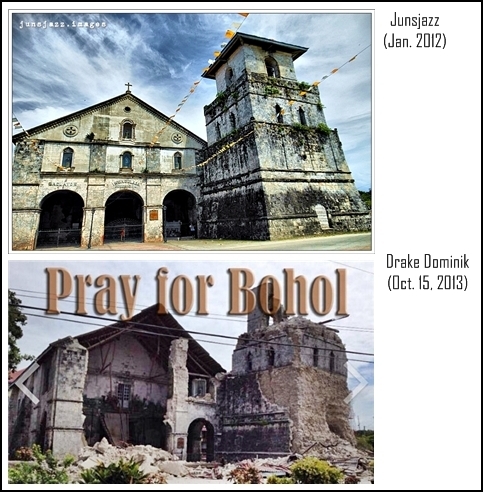 The Church of Our Lady of the Immaculate Conception in Baclayon town, Bohol. Built in 1717.
The Church of Our Lady of the Immaculate Conception in Baclayon town, Bohol. Built in 1717.
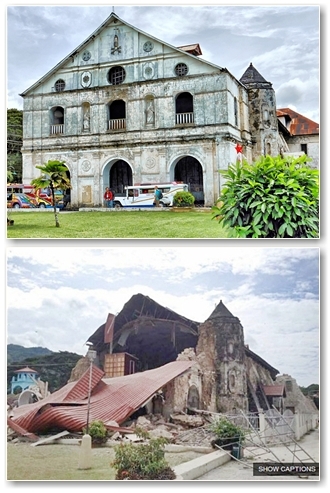 The Church of San Pedro in Loboc, Bohol, originally built in 1602.
The Church of San Pedro in Loboc, Bohol, originally built in 1602.
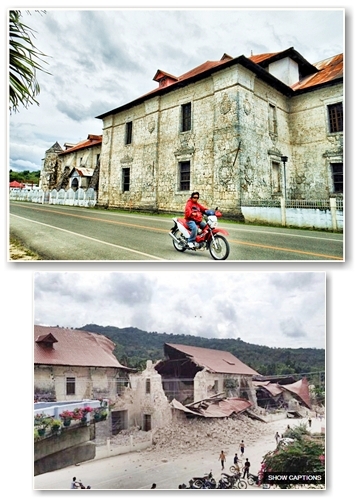
Another picture of the Loboc Church, from the side.
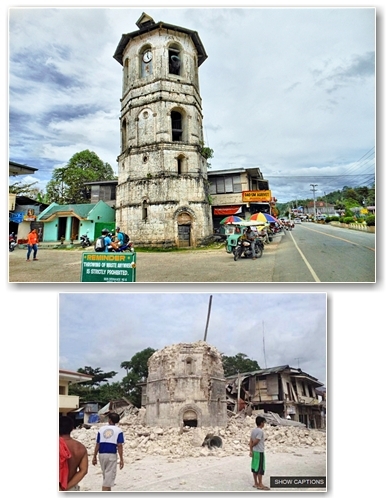 The original bell tower of Loboc Church stands some 100 meters away from the church structure. Now it’s just a stump on the ground.
The original bell tower of Loboc Church stands some 100 meters away from the church structure. Now it’s just a stump on the ground.
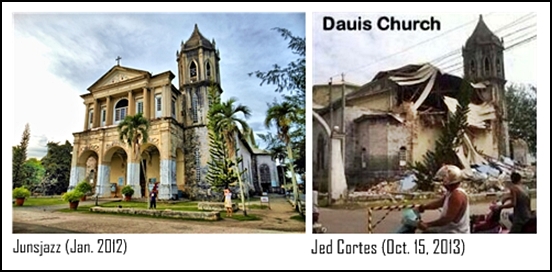 The Church of Our Lady of the Assumption in Dauis, Bohol built by Jesuits in mix style but influenced by Byzantine and Romanesque architecture.
The Church of Our Lady of the Assumption in Dauis, Bohol built by Jesuits in mix style but influenced by Byzantine and Romanesque architecture.
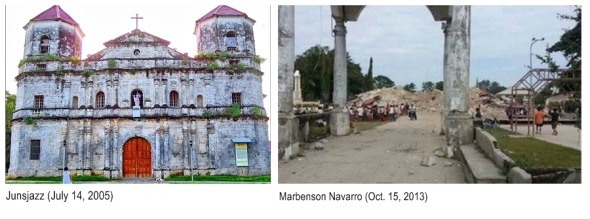 The Church of Our Lady of Light in Loon, Bohol was the biggest church in the province, built in 1753. The whole structure was pulverized to the ground.
The Church of Our Lady of Light in Loon, Bohol was the biggest church in the province, built in 1753. The whole structure was pulverized to the ground.
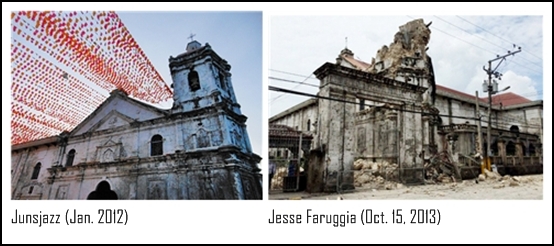 The Minor Basilica of the Holy Child in Cebu City, founded in 1565. It’s belfry fell off.
The Minor Basilica of the Holy Child in Cebu City, founded in 1565. It’s belfry fell off.
These old churches were built with materials during those times – coral stones, mud bricks, limestones – and are most fragile. Throughout their history, they have been subjected to fires, typhoons, previous earthquakes and even World War II. They were the first to come down during the powerful quake this week. Experts are assessing if some of them can be rebuilt, while others like the Loon Church which was flattened, may have a new church built on the site. I am quite fortunate to have captured the beauty and grandeur of these churches in their original condition before the disaster. Now I have them immortalized in images, and preserved in my memory as I saw them in their full glory.
Note: These churches are featured in Junsjazz Images & Inspiration Digital Magazine Issue #2.
The mark of its maker
Outlines, forms, shadows, shapes, lines, light, tones, textures – these are the ingredients of black and white photography. Have fun with your imagery. Play with the elements and composition. Love the light. Bask in contrast. Experiment. Crop to exclude and emphasize. Discover. Assess with your eye. Process with your brain. Capture with your heart. With these, I can offer no other more meaningful tips when it comes to making monochrome images. With tools and knowledge, it all boils down to you – the creator and artist. After all, each picture is an individual mark of its maker.
Symbols of faith redux
I never thought I had so many church articles and images already posted in the past nine months. I’d like to repost the article but pair it with altogether different images. This is titled Symbols of Faith posted last November 27, 2012.
I have around five previous posts regarding pictures of churches and how to photograph them. I can’t get enough of them so here’s another one which is probably not the last since I have a whole collection of them. My country the Philippines has a population of 95 million and 90 percent of them are Catholics. It is the only predominantly Catholic country in Asia, brought about by 300 years of Spanish colonial rule which started in the 1500s. The influence of religion is thus ingrained and pervasive in the peoples’ psych and culture, and most evident in the places of worship. From the far-flung towns to the urban centers, church structures abound, from the modern to the centuries old. They stand as symbols of faith, much like the Muslim mosques and the Buddhist temples. To individuals like me, churches, basilicas and cathedrals are profound photographic subjects. They have this visual grandeur and alluring solemnity. They invoke an aura of mysticism, serenity and of course spirituality. Those are intangibles that are represented in what we can see – the shapes, form, patterns, details, lines – elements which are in the microcosm of the physical church structure whether in its cavernous interior or its towering exterior. When you get the chance to tour my country, make it a point to visit the churches. First give thanks to the Almighty for all the blessings he has given you in this life, then pray that all the pictures you’ll take afterwards will be sharp, vivid, clear and in focus. Amen.
(Picture on top is the Miag-ao Church in Iloilo province – one of four Baroque churches in the Philippines listed in the UNESCO World Heritage Sites, while below is the Pan-ay Cathedral in the province of Capiz)
Symbols of faith
 I have around five previous posts regarding pictures of churches and how to photograph them. I can’t get enough of them so here’s another one which is probably not the last since I have a whole collection of them. My country the Philippines has a population of 95 million and 90 percent of them are Catholics. It is the only predominantly Catholic country in Asia, brought about by 300 years of Spanish colonial rule which started in the 1500s. The influence of religion is thus ingrained and pervasive in the peoples’ psych and culture, and most evident in the places of worship. From the far-flung towns to the urban centers, church structures abound, from the modern to the centuries old. They stand as symbols of faith, much like the Muslim mosques and the Buddhist temples. To individuals like me, churches, basilicas and cathedrals are profound photographic subjects. They have this visual grandeur and alluring solemnity. They invoke an aura of mysticism, serenity and of course spirituality. Those are intangibles that are represented in what we can see – the shapes, form, patterns, details, lines – elements which are in the microcosm of the physical church structure whether in its cavernous interior or its towering exterior. When you get the chance to tour my country, make it a point to visit the churches. First give thanks to the Almighty for all the blessings he has given you in this life, then pray that all the pictures you’ll take afterwards will be sharp, vivid, clear and in focus. Amen. (Photo location: Dauis Church, Panglao Island)
I have around five previous posts regarding pictures of churches and how to photograph them. I can’t get enough of them so here’s another one which is probably not the last since I have a whole collection of them. My country the Philippines has a population of 95 million and 90 percent of them are Catholics. It is the only predominantly Catholic country in Asia, brought about by 300 years of Spanish colonial rule which started in the 1500s. The influence of religion is thus ingrained and pervasive in the peoples’ psych and culture, and most evident in the places of worship. From the far-flung towns to the urban centers, church structures abound, from the modern to the centuries old. They stand as symbols of faith, much like the Muslim mosques and the Buddhist temples. To individuals like me, churches, basilicas and cathedrals are profound photographic subjects. They have this visual grandeur and alluring solemnity. They invoke an aura of mysticism, serenity and of course spirituality. Those are intangibles that are represented in what we can see – the shapes, form, patterns, details, lines – elements which are in the microcosm of the physical church structure whether in its cavernous interior or its towering exterior. When you get the chance to tour my country, make it a point to visit the churches. First give thanks to the Almighty for all the blessings he has given you in this life, then pray that all the pictures you’ll take afterwards will be sharp, vivid, clear and in focus. Amen. (Photo location: Dauis Church, Panglao Island)
Capture the grandeur
 I mentioned in an earlier post that one of my favorite subjects are churches, cathedrals and basilicas. The older and bigger, the better. However, the structure itself as a whole is not the only subject. One can spend a whole day photographing the inside and outside of a church and everything in it – architectural details, columns, pillars, stained glass windows, ornate doors, altars, arches, rows of candles, decors, statues, cavernous ceilings, paintings, artworks, pews, belfries, bells, lamps and a whole lot of interesting subjects. And the church-goers, of course. I found a great article titled A Comprehensive Guide to Photographing Churches, Cathedrals and Castles. When you hear mass or go to church service this weekend, bring along your camera. After reading the article, you just might see these solemn structures on a whole different light. (Photo location: Our Lady of Mt. Carmel Church, Lipa City, Batangas province)
I mentioned in an earlier post that one of my favorite subjects are churches, cathedrals and basilicas. The older and bigger, the better. However, the structure itself as a whole is not the only subject. One can spend a whole day photographing the inside and outside of a church and everything in it – architectural details, columns, pillars, stained glass windows, ornate doors, altars, arches, rows of candles, decors, statues, cavernous ceilings, paintings, artworks, pews, belfries, bells, lamps and a whole lot of interesting subjects. And the church-goers, of course. I found a great article titled A Comprehensive Guide to Photographing Churches, Cathedrals and Castles. When you hear mass or go to church service this weekend, bring along your camera. After reading the article, you just might see these solemn structures on a whole different light. (Photo location: Our Lady of Mt. Carmel Church, Lipa City, Batangas province)
Solemn sanctuaries
 I always have this fascination for church structures, the older and bigger, the more interesting. They are such imposing landmarks with their towering belfries, ornate decors and massive interiors, fulfilling their roles as venerable venues for the faithful, and solemn sanctuaries for the Lord’s flock. The Philippines is a showcase of ancient churches, cathedrals and basilicas. As the only predominantly Catholic country in Asia, churches big and small, old and new abound all over the Philippines. One of the well known relic religious structures is the Miag-ao Church in the province of Iloilo. Built in 1786 by Spanish Augustinian missionaries, it is one of four Baroque-inspired churches in the Philippines that is included in the UNESCO World Heritage Sites.
I always have this fascination for church structures, the older and bigger, the more interesting. They are such imposing landmarks with their towering belfries, ornate decors and massive interiors, fulfilling their roles as venerable venues for the faithful, and solemn sanctuaries for the Lord’s flock. The Philippines is a showcase of ancient churches, cathedrals and basilicas. As the only predominantly Catholic country in Asia, churches big and small, old and new abound all over the Philippines. One of the well known relic religious structures is the Miag-ao Church in the province of Iloilo. Built in 1786 by Spanish Augustinian missionaries, it is one of four Baroque-inspired churches in the Philippines that is included in the UNESCO World Heritage Sites.






















